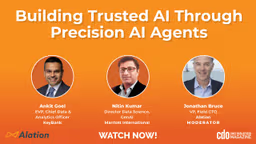AI News Bureau
All Our Data Initiatives Undergo Cross-functional Review — Toyota Motor North America Head of Enterprise AI
Written by: CDO Magazine Bureau
Updated 12:00 PM UTC, Wed August 13, 2025
Toyota Motor Corporation, a global leader in automotive manufacturing. Known for its relentless focus on quality, safety, and innovation, Toyota has invested heavily in emerging technologies, including artificial intelligence (AI) and advanced analytics, to accelerate its transformation into a mobility company of the future.
In the first installment of this three-part series, Brian Kursar, Group Vice President and Head of Enterprise AI at Toyota Motor North America, spoke with Lance Walter, CMO of Prophecy, about Toyota’s AI adoption journey, bridging generational knowledge gaps, and why responsible data practices are foundational to innovation.
In this second part, Kursar dives deeper into how Toyota is expanding the definition of data, building responsible governance for AI at scale, and balancing innovation with safety and consistency across its global enterprise.
Rethinking what counts as data
Traditionally, data in business has meant structured information from transactional systems and dashboards. Kursar explains that Toyota’s AI strategy takes a much broader view of what counts as valuable data for innovation.
“Today, in your databases you have structured transactional data, unstructured data, but generally you don’t have things like code in a data and analytics organization’s data lakes,” says Kursar. “We started thinking, how can we leverage AI to improve the quality of even things like code quality? It’s about thinking broadly.”
This broader definition includes not only structured and unstructured data but also code repositories, documents stored in platforms like SharePoint and OneDrive, videos, audio files, and repair manuals.
“When you start bringing all of this together,” Kursar explains, “you start recognizing that the opportunity to be more efficient, more thoughtful on what you can do with AI just opens up.”
He points to software development as a practical example. Using AI to automatically generate unit tests has transformed the pace and quality of coding: “There’s no real excuse to ever not have 100% code coverage now. AI makes it easy to create these test cases instantly. We’re not just writing code faster — we’re writing higher-quality code.”
Building responsible AI governance
Expanding the data universe for AI also means navigating new risks. Toyota’s approach relies on strong governance frameworks to ensure that AI adoption remains responsible and trustworthy.
“We have the Responsible AI Review Board,” Kursar says. “Everything we want to do with data, whether for customers, employees, or the company, we review from a cross-functional perspective. Cybersecurity, legal, privacy, enterprise architecture, everyone is involved.”
This governance process ensures that AI initiatives comply with customer consent requirements, cybersecurity standards, and privacy policies.
Kursar highlights that some AI service providers may not adhere to Toyota’s internal security policies, making vigilance essential: “It was very important for us to know where the data is going and make sure the companies we work with comply with our cybersecurity and privacy policies. We have to be above board with everything we do.”
Balancing innovation and safety in a complex enterprise
For a company the size of Toyota, with thousands of employees and a vast technology landscape, balancing speed, empowerment, and safety is crucial. To achieve this, Kursar’s team established a dedicated AI group that works closely with cybersecurity leaders to evaluate and approve new technologies.
“We have an amazing relationship with our cybersecurity team. We vet out new technologies, create a published page of approved standards and models, and make sure terms and conditions are agreed to by the hyperscalers. That way, we are ultimately protected.”
This proactive approach allows Toyota employees to explore new AI tools without security concerns holding them back: “A model comes out, and maybe two weeks later we have it available for people to experiment,” Kursar says. “Our hackathons push everyone to be innovative, and now they know exactly which models they can use safely. We want our teams to be as creative as possible for the benefit of our customers and the company.”
CDO Magazine appreciates Brian Kursar for sharing his insights with our global community.






